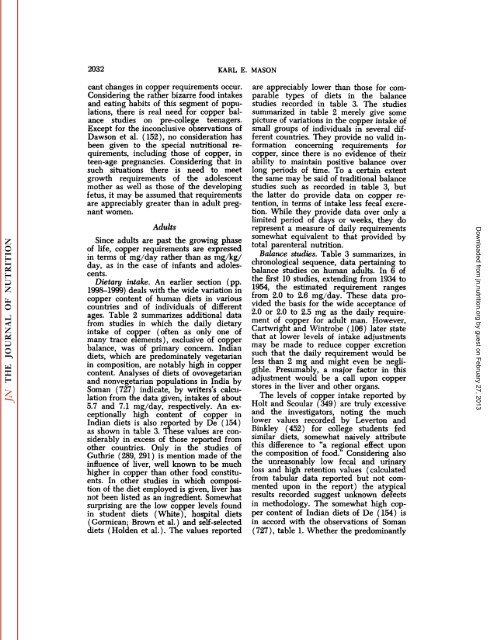conspectus of researchon copper metabolism and requirements
conspectus of researchon copper metabolism and requirements
conspectus of researchon copper metabolism and requirements
You also want an ePaper? Increase the reach of your titles
YUMPU automatically turns print PDFs into web optimized ePapers that Google loves.
2032 KARL E. MASON<br />
cant changes in <strong>copper</strong> <strong>requirements</strong> occur.<br />
Considering the rather bizarre food intakes<br />
<strong>and</strong> eating habits <strong>of</strong> this segment <strong>of</strong> popu<br />
lations, there is real need for <strong>copper</strong> bal<br />
ance studies on pre-college teenagers.<br />
Except for the inconclusive observations <strong>of</strong><br />
Dawson et al. ( 152 ), no consideration has<br />
been given to the special nutritional re<br />
quirements, including those <strong>of</strong> <strong>copper</strong>, in<br />
teen-age pregnancies. Considering that in<br />
such situations there is need to meet<br />
growth <strong>requirements</strong> <strong>of</strong> the adolescent<br />
mother as well as those <strong>of</strong> the developing<br />
fetus, it may be assumed that <strong>requirements</strong><br />
are appreciably greater than in adult preg<br />
nant women.<br />
Adults<br />
Since adults are past the growing phase<br />
<strong>of</strong> life, <strong>copper</strong> <strong>requirements</strong> are expressed<br />
in terms <strong>of</strong> mg/day rather than as mg/kg/<br />
day, as in the case <strong>of</strong> infants <strong>and</strong> adoles<br />
cents.<br />
Dietary intake. An earlier section (pp.<br />
1998-1999) deals with the wide variation in<br />
<strong>copper</strong> content <strong>of</strong> human diets in various<br />
countries <strong>and</strong> <strong>of</strong> individuals <strong>of</strong> different<br />
ages. Table 2 summarizes additional data<br />
from studies in which the daily dietary<br />
intake <strong>of</strong> <strong>copper</strong> (<strong>of</strong>ten as only one <strong>of</strong><br />
many trace elements), exclusive <strong>of</strong> <strong>copper</strong><br />
balance, was <strong>of</strong> primary concern. Indian<br />
diets, which are predominately vegetarian<br />
in composition, are notably high in <strong>copper</strong><br />
content. Analyses <strong>of</strong> diets <strong>of</strong> ovovegetarian<br />
<strong>and</strong> nonvegetarian populations in India by<br />
Soman (727) indicate, by writers's calcu<br />
lation from the data given, intakes <strong>of</strong> about<br />
5.7 <strong>and</strong> 7.1 mg/day, respectively. An ex<br />
ceptionally high content <strong>of</strong> <strong>copper</strong> in<br />
Indian diets is also reported by De ( 154)<br />
as shown in table 3. These values are con<br />
siderably in excess <strong>of</strong> those reported from<br />
other countries. Only in the studies <strong>of</strong><br />
Guthrie (289, 291) is mention made <strong>of</strong> the<br />
influence <strong>of</strong> liver, well known to be much<br />
higher in <strong>copper</strong> than other food constitu<br />
ents. In other studies in which composi<br />
tion <strong>of</strong> the diet employed is given, liver has<br />
not been listed as an ingredient. Somewhat<br />
surprising are the low <strong>copper</strong> levels found<br />
in student diets (White), hospital diets<br />
(Gormican; Brown et al.) <strong>and</strong> self-selected<br />
diets (Holden et al.). The values reported<br />
are appreciably lower than those for com<br />
parable types <strong>of</strong> diets in the balance<br />
studies recorded in table 3. The studies<br />
summarized in table 2 merely give some<br />
picture <strong>of</strong> variations in the <strong>copper</strong> intake <strong>of</strong><br />
small groups <strong>of</strong> individuals in several dif<br />
ferent countries. They provide no valid in<br />
formation concerning <strong>requirements</strong> for<br />
<strong>copper</strong>, since there is no evidence <strong>of</strong> their<br />
ability to maintain positive balance over<br />
long periods <strong>of</strong> time. To a certain extent<br />
the same may be said <strong>of</strong> traditional balance<br />
studies such as recorded in table 3, but<br />
the latter do provide data on <strong>copper</strong> re<br />
tention, in terms <strong>of</strong> intake less fecal excre<br />
tion. While they provide data over only a<br />
limited period <strong>of</strong> days or weeks, they do<br />
represent a measure <strong>of</strong> daily <strong>requirements</strong><br />
somewhat equivalent to that provided by<br />
total parenteral nutrition.<br />
Balance studies. Table 3 summarizes, in<br />
chronological sequence, data pertaining to<br />
balance studies on human adults. In 6 <strong>of</strong><br />
the first 10 studies, extending from 1934 to<br />
1954, the estimated requirement ranges<br />
from 2.0 to 2.6 mg/day. These data pro<br />
vided the basis for the wide acceptance <strong>of</strong><br />
2.0 or 2.0 to 2.5 mg as the daily require<br />
ment <strong>of</strong> <strong>copper</strong> for adult man. However,<br />
Cartwright <strong>and</strong> Wintrobe (106) later state<br />
that at lower levels <strong>of</strong> intake adjustments<br />
may be made to reduce <strong>copper</strong> excretion<br />
such that the daily requirement would be<br />
less than 2 mg <strong>and</strong> might even be negli<br />
gible. Presumably, a major factor in this<br />
adjustment would be a call upon <strong>copper</strong><br />
stores in the liver <strong>and</strong> other organs.<br />
The levels <strong>of</strong> <strong>copper</strong> intake reported by<br />
Holt <strong>and</strong> Scoular (349) are truly excessive<br />
<strong>and</strong> the investigators, noting the much<br />
lower values recorded by Leverton <strong>and</strong><br />
Binkley (452) for college students fed<br />
similar diets, somewhat naively attribute<br />
this difference to "a regional effect upon<br />
the composition <strong>of</strong> food." Considering also<br />
the unreasonably low fecal <strong>and</strong> urinary<br />
loss <strong>and</strong> high retention values (calculated<br />
from tabular data reported but not com<br />
mented upon in the report) the atypical<br />
results recorded suggest unknown defects<br />
in methodology. The somewhat high cop<br />
per content <strong>of</strong> Indian diets <strong>of</strong> De ( 154) is<br />
in accord with the observations <strong>of</strong> Soman<br />
(727), table 1. Whether the predominantly<br />
Downloaded from<br />
jn.nutrition.org<br />
by guest on February 27, 2013
















